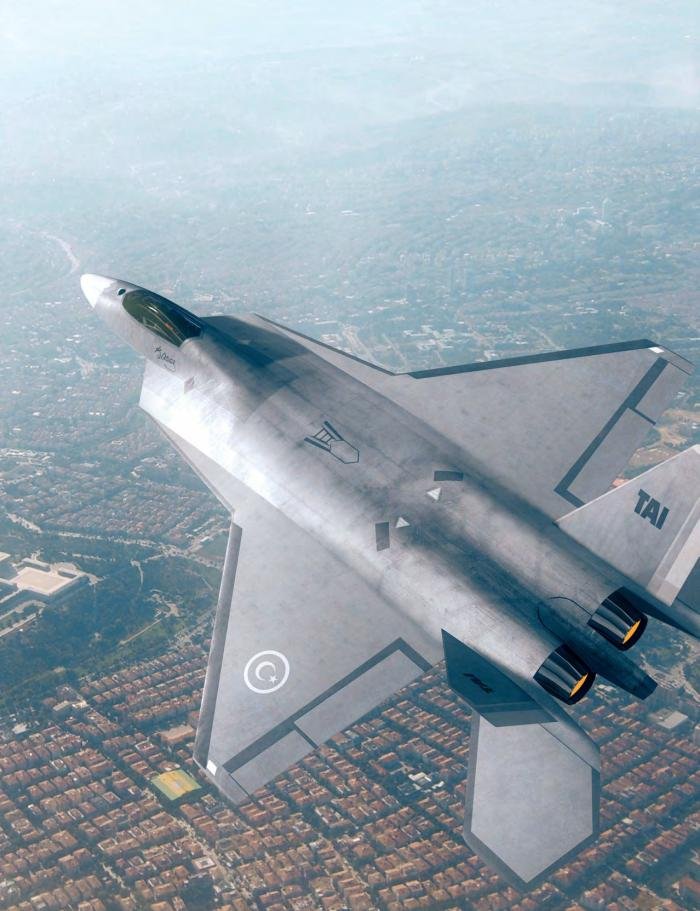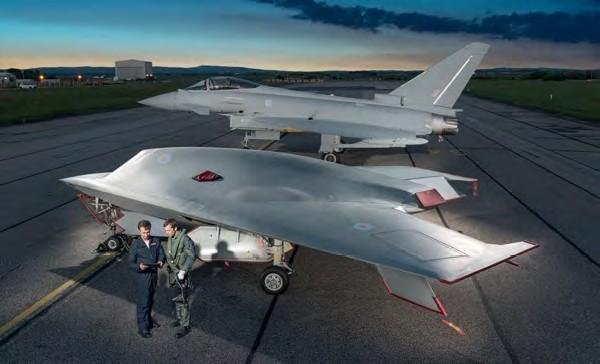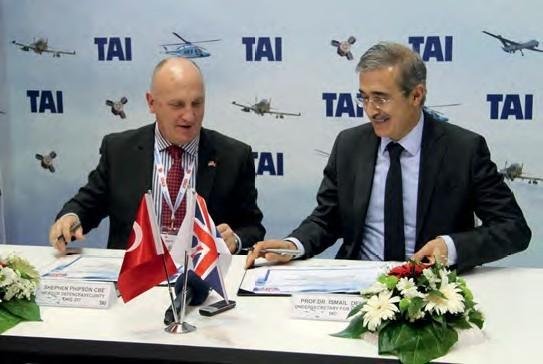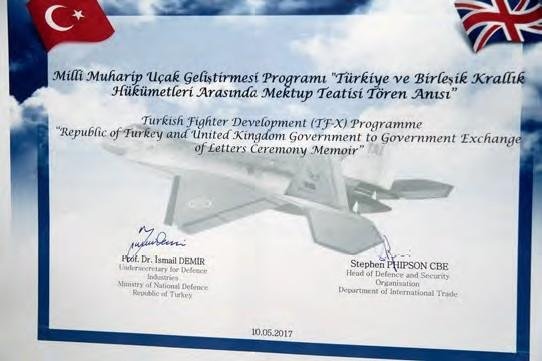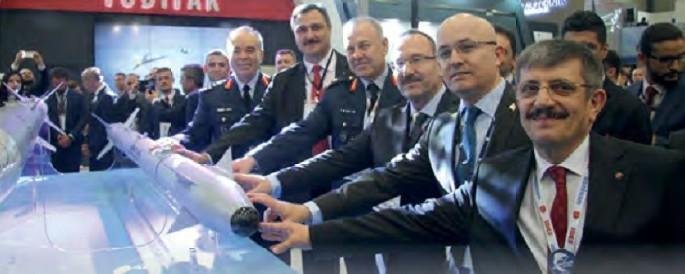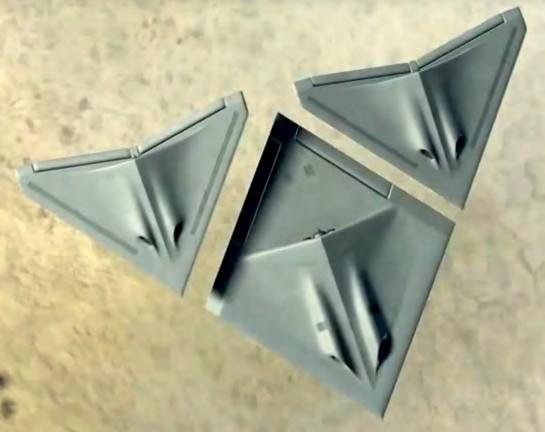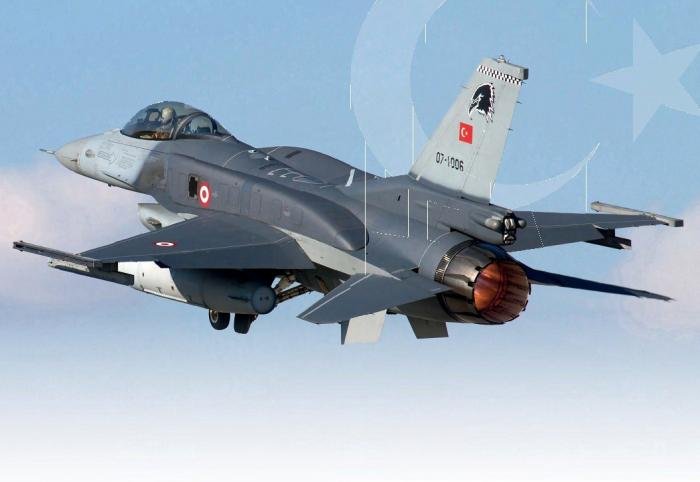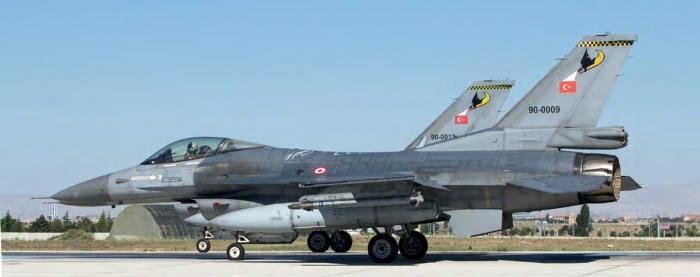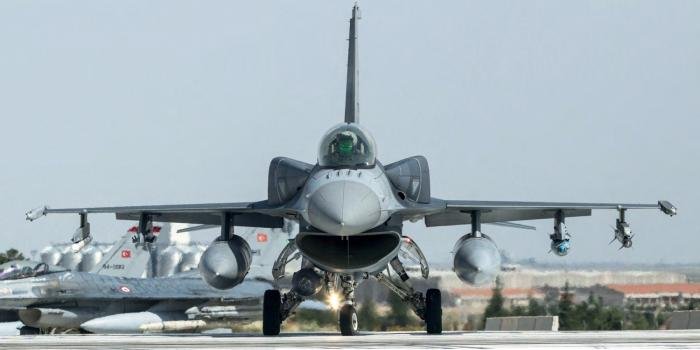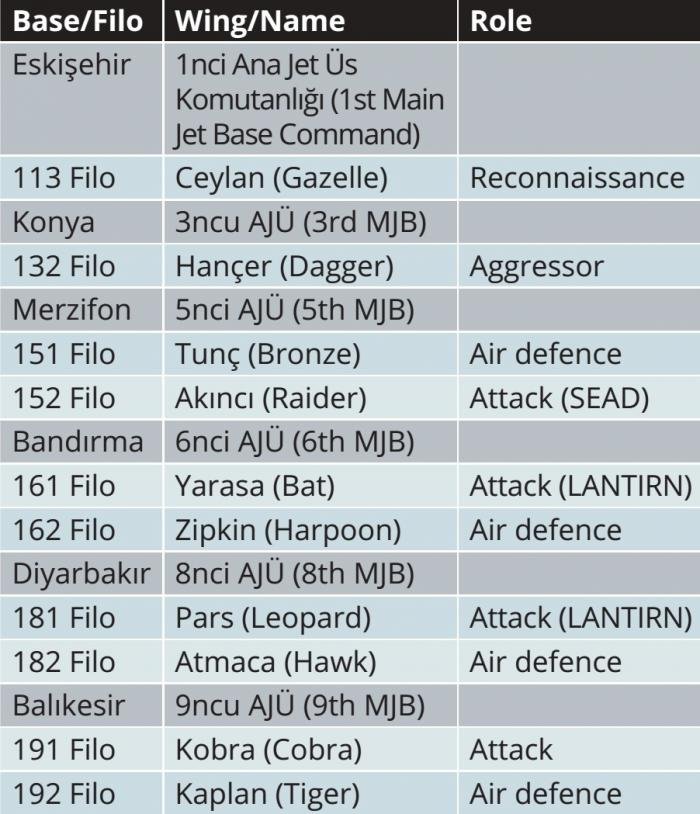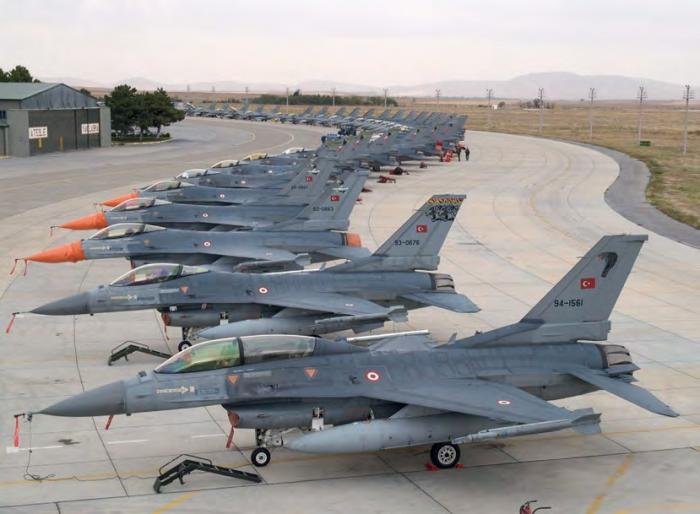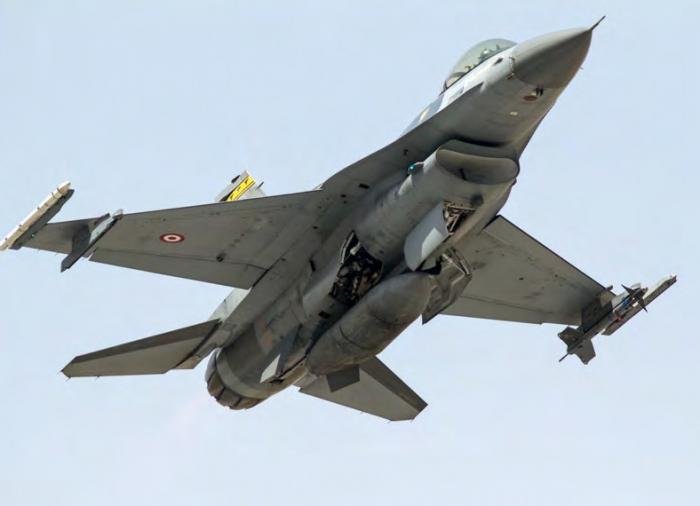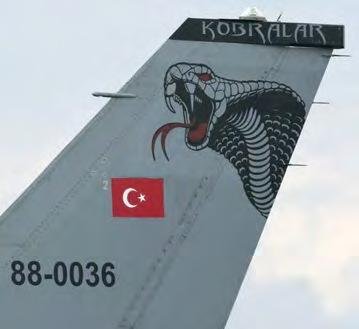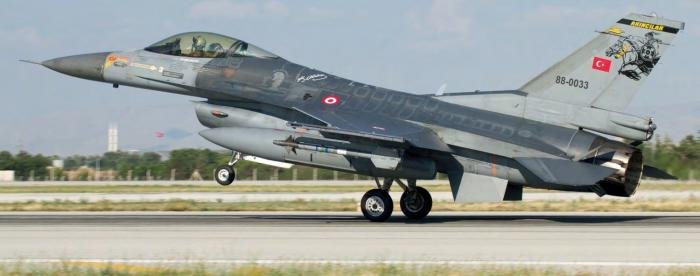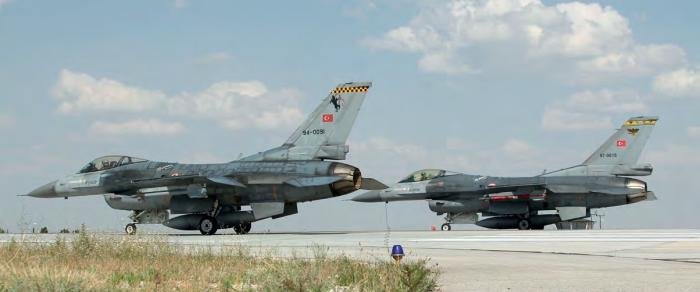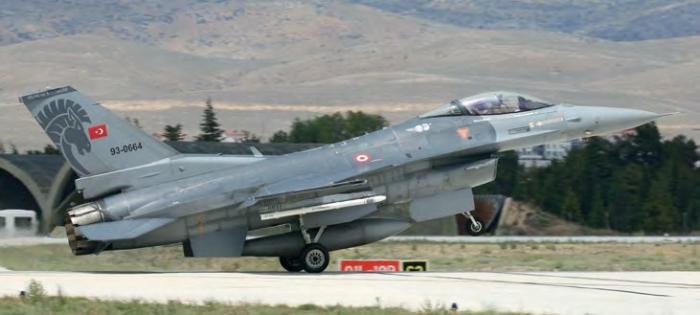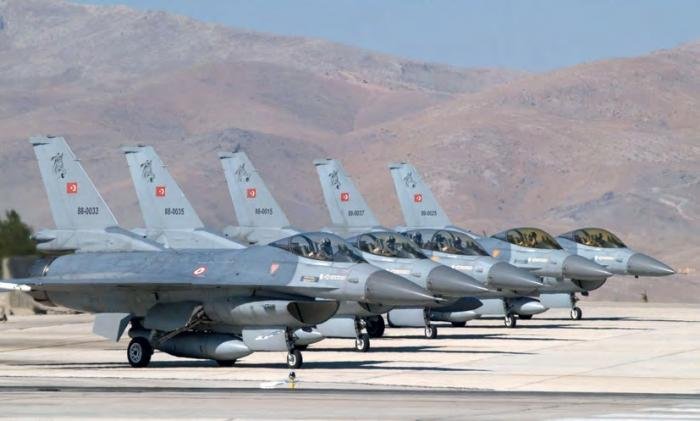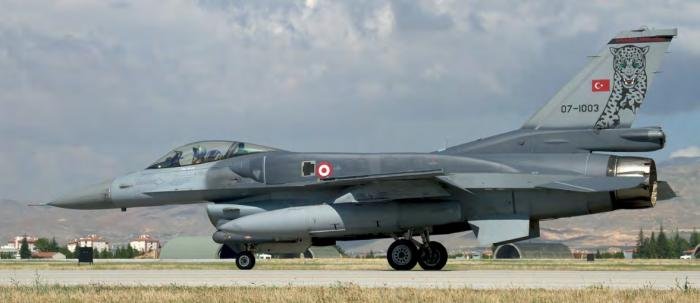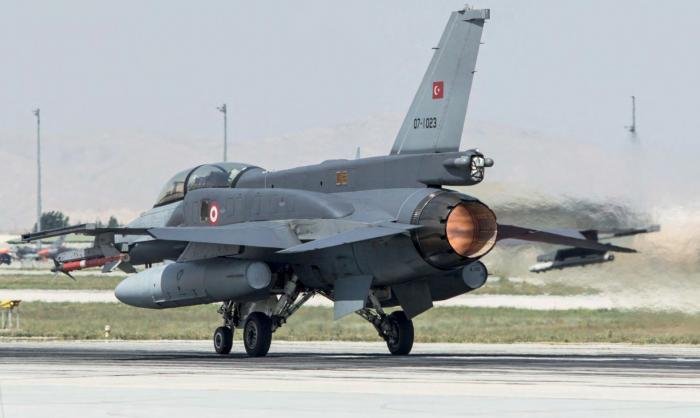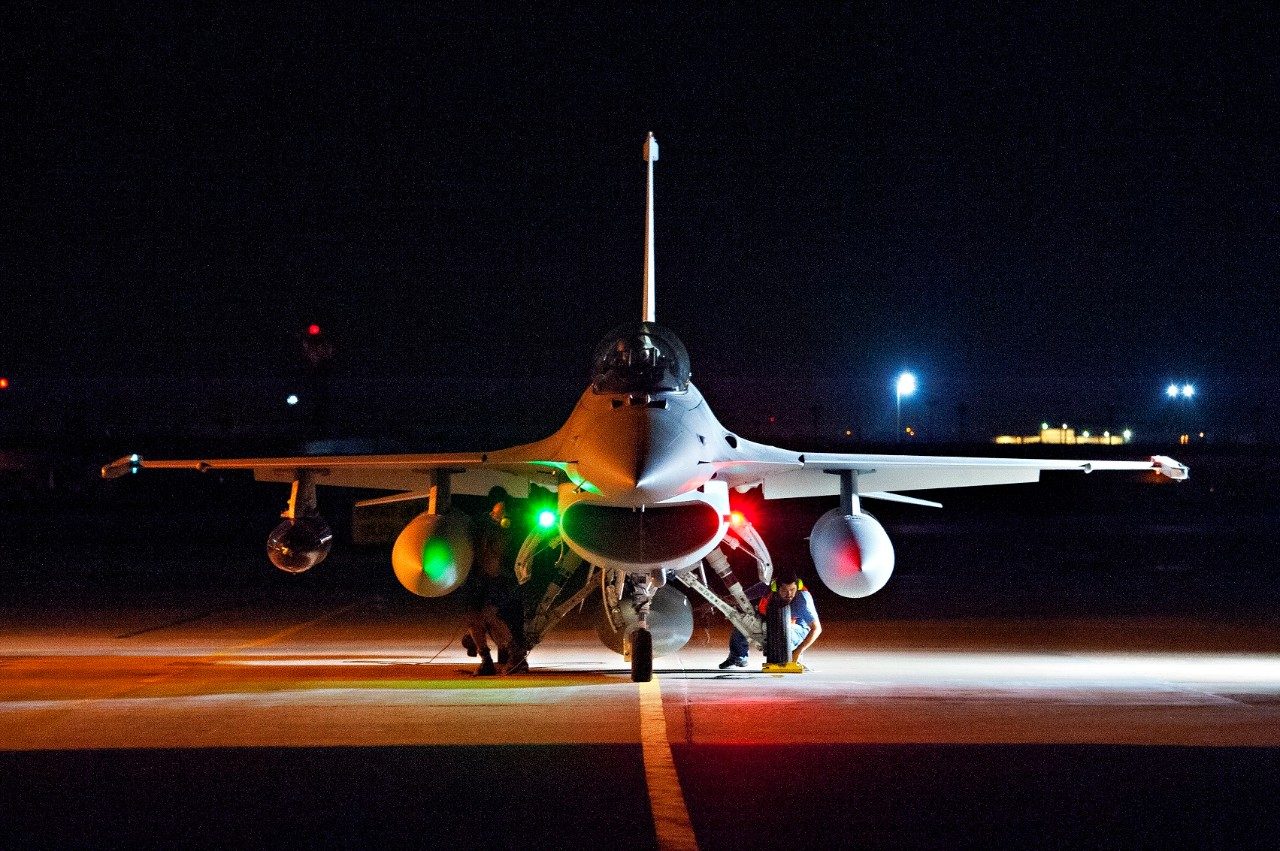Published in 2017. And the story continues.....
THREE DECADES OF TURKISH VIPERS
- Aviation Features
- THREE DECADES OF TURKISH VIPERS
By
Alan Warnes 18th May 2017
FEATURE
Turkey celebrates its 30th anniversary as an F-16 ‘Viper’ operator later this year. Since its first aircraft were delivered in October 1987, the fleet has grown into the third largest after those of the United States and Israel, as AFM’s Alan Warnes reports.
TURKISH F-16S
TURKEY HAS built a strong military to keep safe its borders with Syria, Iraq and Iran and deal with an unpredictable relationship with its NATO ally and neighbour, Greece. The country is in a constant state of high alert and airspace protection is a top priority.
A Russian Aerospace Forces Su-24M was shot down after straying into Turkish airspace on November 24, 2015 by a Türk Hava Kuvvetleri (THK, Turkish Air Force) F-16C, believed to be from 182 Filo at Diyarbakır.
The Su-24M was flying an anti-terrorist mission from its base in Latakia province, Syria. Both crew ejected and while one was rescued by Russian troops, the other was killed by small arms from the ground.
Following the incident, Turkey re-affirmed it would shoot down any aircraft committing such violations.
Turkey’s F-16s are also very capable in the air-to-ground role, and strikes against Partiya Karkerên Kurdistanê (PKK, Kurdish Workers’ Party) militias occur regularly. Among recent operations, a February 27 engagement saw five militant targets bombed.
First combat
Although THK F-16s had confronted Hellenic Air Force jets previously, their first true combat came in April 1993, when the type was deployed to Ghedi, Italy. Eighteen F-16C/ Ds and 24 pilots from 142 Filo at Mürted began the THK’s first overseas combat deployment to an allied base.
Their mission was to enforce NATO’s no-fly zone over Bosnia, under Operation Deny Flight. They were tasked to shoot down any Yugoslavian aircraft ignoring the order.
When the mission evolved into all-out war against Yugoslavia under Operation Allied Force in March 1999, the Ghedi detachment, which had drawn down to only five 182 Filo F-16C/Ds, was expanded to 11 jets. As standard, each aircraft carried two AIM-120 AMRAAMs and four AIM-9M Sidewinders.
While other NATO F-16s habitually carried the AN/ALQ-131 electronic countermeasures pod on their centreline stations, the THK employed the internal Loral AN/ALQ-178. Under constant threat from its neighbours, Turkey had purchased the capability from Loral late in 1988.
Fitted with CFTs, F-16C Block 50 07-1006 of 161 Filo blasts off from Konya. This squadron has a primary air-to-ground role. As of April last year, this particular Peace Onyx IV aircraft was assigned to 181 Filo.
Chris Lofting
When 191 Filo took over from 182 Filo in mid-April, the F-16s added offensive sorties to their tasking, employing Mk 82 bombs. The unit continued at Ghedi until mid-July, when 152 Filo from Merzifon took over, continuing to operate the five jets remaining at the base.
The Turkish detachment ended late in 1999.
Anatolian Eagle
Having seen at first hand the importance of combined air operations with aircraft from other countries, the THK set about creating a major training exercise of its own. Modelled on the Red Flag events at Nellis Air Force Base, Nevada, the first Anatolian Eagle took place in June 2001 and included a mix of 71 THK, US Air Force and Israeli Air Force aircraft. All participating machines carried air combat manoeuvring instrumentation pods. THK F-16s from units across the country were involved. Anatolian Eagle came to play a major role in qualifying personnel for specialist roles, with up to three exercises taking place every year, two of them often bilateral.
As well as attending NATO and Red Flag exercises, Turkish F-16s also held regular manoeuvres with Israeli F-16s until relations soured in May 2010 after an Israeli gunboat attacked a Turkish ship off Gaza. F-16 units also worked with Chinese Su-27s at Konya in 2010, with Azerbaijan Air Force MiG-29s during 2015 and 2016, and visited Mushaf in Pakistan during bilateral Indus Viper manoeuvres with the Pakistan Air Force.
Coup
All manoeuvres and overseas visits stopped after a failed coup on July 15 last year. Much of the THK’s F-16 experience and knowledge has been drained, with hundreds of personnel dismissed and/or imprisoned – the plotters used F-16s in their attempt to overthrow President Recep Erdoğan.
Just months before the rebellion, for example, four F-16Cs and two F-16Ds had deployed to Nellis for a Red Flag, with Colonel Mustafa Erturk, an experienced F-16 pilot, as detachment commander. Erturk, Head of Operations at Konya, was arrested in the coup’s aftermath.
Normally based at Bandırma’s 6nci AJÜ, this pair of 162 Filo Block 40 F-16s was detached to the 3rd Main Jet Base at Konya for the two-week Anatolian Eagle exercise, where they are seen preparing for an afternoon mission.
Derek Bower
Losing such highly-experienced personnel, along with their knowledge and skills, has had a detrimental effect on the operational fleet, which was previously revered as one of the best in the world.
After the attempted coup, Ankara-Akıncı, home of 4 Ana Jet Üs (4 AJÜ, 4th Air Wing) was immediately closed. Its name has since reverted to Mürted, as it was known prior to 1997; the word means ‘coward’ in Mongol, hence its original replacement and the Turkish government’s decision to use it again. Its future is unclear, although there is speculation that it could be used as an aerospace test and evaluation facility, since Turkish Aerospace Industries (TAI) is stationed on the other side of the runway.
Akıncı’s three resident F-16 units, 141 ‘Kurt’, 142 ‘Ceylan’ and 143 ‘Öncel’ Filos have been disbanded and their aircraft dispersed between Eskişehir, Konya and Merzifon. At Eskişehir, to the west of Ankara, 113 Filo, which flew reconnaissance with RF-4Es until March 12, 2015, now operates ex-142 Filo F-16s that can be equipped with the UTC Aerospace Systems DB-110 reconnaissance pod. On re-equipment, 113 Filo adopted 142’s ‘Ceylan’ (Gazelle) traditions in place of its former ‘Işık’ (Light) heritage. In the process, the previously 12-squadron operational F-16 fleet has been reduced to ten.
Four DB-110 systems are known to have been acquired for the F-16 under the Turkish Airborne Reconnaissance Programme (TARP).
The TARP contract also included three UTC-supplied fixed/transportable imagery exploitation systems.
A Block 50+ F-16 departs runway 01R at Konya with almost all the stores pylons occupied, and with additional fuel in conformal fuel tanks (CFTs) and drop tanks.
Derek Bower
This impressive line-up of F-16s seen at Anatolian Eagle 2004 and headed up by a 191 Filo F-16D includes over 20 Turkish examples from various units.
Alan Warnes
Peace Onyx I
When Turkey selected the General Dynamics (later Lockheed and eventually Lockheed Martin) F-16 to fulfil its new fighter requirements in 1984, it also kick-started its aerospace industry. An offset agreement led to the construction of F-16 production facilities, now known as TAI, opposite the military installation at Mürted.
Under the $4.2bn Peace Onyx I (PO I) deal, in September 1983, Türkiye Uçak Sanayii AS (TUSAS, Turkish Aerospace Industries, predecessor to TAI) was contracted to build 160 F-16s, sufficient to re-equip eight F-5/F-104 squadrons. Contributions from local sources ($1bn), offsets ($1.5bn) and Foreign Military Sales (FMS) aid ($1.7bn) funded the deal. TUSAS built 70% of each F-16, including the centre/aft fuselage and wings. The requirements of the F-16s’ General Electric F110 engines led to a Units specialise in particular roles, including air defence, suppression of enemy air defences (SEAD)/ destruction of enemy air defences, tactical air support for maritime operations, close air support, reconnaissance and aggressor, with their aircraft equipped as required. The 401 ‘Test Filosu’ (401 Test Flight) recently stood up at Eskişehir, tasked with testing weapons and systems/software upgrades designed by the Turkish aerospace industry.
F-16C/D units
TAI upgraded 163 F-16s at its facilities under Peace Onyx III – completing the work in April 2015.
Alan Warnes
$56m engine factory being built at Eskişehir and today known as Tusaş Engine Industries (TEI).
Peace Onyx I comprised 128 F-16Cs and 32 F-16Ds, General Dynamics building two of the F-16Cs (86-0066 to 067) and six F-16Ds (86- 0191 to 86-0196) at Fort Worth, for delivery in October 1987. The first of 152 locally produced F-16s (F-16D 86-0068) flew on October 20, 1987 after plans to build the 32 F-16Ds from Complete Knock Down Kits (CKDs) were abandoned. Later, the variant mix was changed to 24 F-16Ds and 136 F-16Cs.
The first 44 jets (35 ’Cs and nine ’Ds) were built to Block 30 standard for the operational conversion unit, known as Öncel and later designated as 143 Filo, and 141 and 142 Filo, all at Mürted. Built from the early 1990s, the remaining 116 aircraft were finished to Block 40 standard with provision for Low-Altitude Navigation and Targeting by Infra-Red at Night (LANTIRN) pods.
The PO I assembly process at Mürted was completed in 1995, when the 152nd F-16 was delivered. After deliveries to 4nci AJÜ at Mürted, 6nci AJÜ at Bandırma received F-16s in 1991/92, followed by 9nci AJÜ at Balıkesir, before F-16s replaced 8nci AJÜ’s CF-104 Starfighters at Diyarbakır. Last to convert, 5nci AJÜ at Merzifon phased its F-5s out in favour of the first Peace Onyx II jets.
Peace Onyx II
Even before PO I deliveries had been completed, a contract for 68 F-16C and 12 F-16D Block 50 aircraft (later amended to cover 60 F-16Cs and 20 F-16Ds) was signed under PO II, in March 1992. It ensured there was no lapse in production, with delivery of the first PO II aircraft (93-0657) taking place in July 1996; its career was short-lived, however, since it was involved in a collision on April 4, 2000. One of the pilots was killed, while the other ejected safely.
Previously assigned to the 4th Jet Base at Akıncı, after the failed coup of July 15, 2016, this 143 Filo airframe was reassigned to the 5th Main Jet Base at Merzifon.
Derek Bower
The THK’s official Red Air unit is 132 Filo at Konya, which is kept busy training with other squadrons. This example is a Peace Onyx II aircraft fitted with an ACMI pod.
Alan Warnes
Compare the unit marks of the aircraft at Anatolian Eagle 2004 (see previous page) with the current flamboyant mural of 191 Filo.
Alan Warnes
Mixed squadrons often operate together during Anatolian Eagle exercises at the 3rd Main Jet Base at Konya. The nearest airframe is from 152 Filo based at Merzifon, while the other example was at the time allocated to 143 Filo at Akıncı, which has since become a reserve base.
Derek Bower
F-16C 88-0033 of 152 Filo features ‘Savaşan Anka’ (‘Fighting Phoenix’) nose art. This commemorates the fact that this Block 40 aircraft was badly damaged in a belly landing and, although Lockheed Martin deemed the aircraft a write-off, the THK returned it to the air after two years of repairs.
Chris Lofting
Financing for PO II came from the Turkish Defence Fund, established by Kuwait, Saudi Arabia, the US and the United Arab Emirates in recognition of Turkey’s support during the 1991 Gulf War.
Lockheed Martin commended TAI for its workmanship on PO II F-16C ‘4R-23’ (88-0021), which was certified as ‘perfect’, entirely without snags, when it left the production hall. On November 12, 1999, TAI’s production line closed after the last PO II F-16C was handed over.
Peace Onyx III
The Peace Onyx III FMS contract, agreed in April 2005, was for the Common Configuration Implementation Program (CCIP) upgrade. This improves operational flexibility and logistics support, and reduces life-cycle costs, as well as enabling compatibility with more modern, ‘smarter’ weapons and sensors.
Lockheed Martin supplied 163 Government Furnished Equipment (GFE) kits for Turkey’s surviving 163 F-16 Block 40/50s. Each comprised the APG-68(V)9 multi-mode radar, colour cockpit displays and recorders, new core avionics processors, Joint Helmet- Mounted Cueing System (JHMCS), Link 16 data link, APX-113 Advanced IFF interrogator/ transponder, integrated precision navigation GPS/INS, an upgraded version of the Self- Protection Electronic Warfare System (including AN/ALQ-178(V)5+) and compatibility with several new targeting systems and weapons, including AIM-9X.
The upgrade was implemented in two parts.
Under the initial phase, Lockheed Martin contracted TAI to modify ten F-16s. Of these, one F-16C Block 40 and one Block 50, plus one F-16D Block 40 and one Block 50, were flown to Lockheed Martin’s Fort Worth facility in July 2009 for test and verification work on the new systems. They were tested with a variety of weapons and sensors, including LANTIRN and Sniper pods. The F-16Ds returned to Turkey in July 2011, followed by the F-16Cs in August 2012. The remaining six aircraft were handed to Lockheed Martin in Turkey, which ensured the work met its stringent quality standards, before delivery to the THK.
Five Block 30 F-16C/Ds line up at Konya Air Base in June 2004 for an Anatolian Eagle exercise. The aircraft were by this stage wearing squadron markings, although not as bold as they are now. They belong to 141 Filo which, following the attempted coup last July, was disbanded and its Akıncı base closed down.
Alan Warnes
Peace Onyx
Part of the Peace Onyx III order, F-16D 94-0110 received a special scheme to celebrate 50 years of 141 Filo in 2015.
Chris Lofting
The second part of PO III then began, TAI integrating the GFE kits through a modernisation and serial assembly upgrade.
At the height of its integration work, 45 THK F-16s could be seen at TAI’s facilities at any one time. In a bid to speed up the process, 16 were worked at the 1st Air Supply and Maintenance Centre, Eskişehir. The final aircraft, F-16D Block 40 89-0044, was handed back to the THK on April 10, 2015 during a ceremony at TAI’s Ankara facility.
Peace Onyx IV
Under Peace Onyx IV, the THK acquired 30 Block 50+ F-16s, leading TAI to re-open its F-16 production line, which had lain dormant since 1999. An FMS deal between TAI and Lockheed Martin was signed on December 5, 2008 for 14 F-16Cs and 16 F-16Ds. They have identical advanced systems and equipment fit, but the two-seaters fly as tactical attack aircraft. The bulk was delivered to the two LANTIRN units – 161 Filo at Bandırma and 181 Filo at Diyarbakır, and the Akıncı squadrons, 141 and 142 Filo, since disbanded.
Manufacturing started in early 2010 and the first aircraft, F-16D 07-1015, was delivered on May 23, 2011. It appeared at Air Show Türkiye, the THK’s 100th anniversary show at Izmir, in June 2011, carrying the indigenous 1,300lb (590kg) Roketsan Stand Off Missile (SOM). All PO IV F-16C/Ds are compatible with SOM, as well as the other indigenous weapons, including the new Nüfuz Edici Bomba (NEB, Penetrating Bomb) and KGK-82 INS/GPS-guided bomb.
The initial PO IV F-16D left Turkey for test and evaluation at Fort Worth in July 2011, returning with the F-16C Block 50 in August 2012. On December 11, 2012, the THK took delivery of the final pair of PO IV jets (F-16Ds 07-1029 and 07-1030), signalling termination of the production line.
A modernisation programme for 35 Block 30s now occupies TAI’s F-16 business.
According to its Aircraft Division Manager, Özcan Ertem: “TAI already has a turnkey contract with SSM [Savunma Sanayii Müsteşarlığı, Turkish Defence Industry] for life extensions on all 35 Block 30s. Lockheed Martin is supplying kits, while TAI will complete the modifications and ground/flight testing. Two lead-the-fleet aircraft (one F-16C and one F-16D) will begin the modification process, with serial modification from 2018.”
Nonetheless, TAI’s F-16 business is declining.
It is always interested in additional F-16 work, but the forthcoming F-35A should take up some of its spare capacity. With the Turkish Fighter programme (TF-X) also on the horizon, TAI is likely to remain busy.
F-16C Block 50 07-1003 of 181 Filo during an Anatolian Eagle exercise at Konya.
Chris Lofting
A Block 50+ F-16D departs Konya in full afterburner as part of a 60-aircraft mission package over the Anatolian Eagle exercise range areas.
Derek Bower
Originally published in AirForces Monthly Magazine






